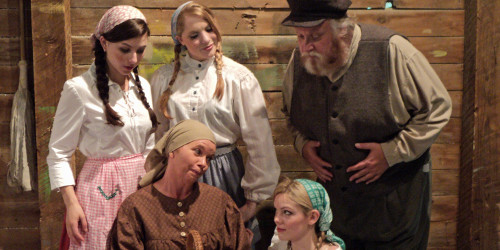By John Quinn

In musical theater, as in much of life, they just don't make 'em like they used to. Mounting the average Broadway musical runs about $9.4 million nowadays, and producers are loath to take risks. Shows are frequently rehashes of other genre, filled with whizz-bang effects. Some are successful; some are "Spiderman: Turn off the Dark."
When a company like Tibbits Summer Theatre tackles one of the great standards of musical theater, it is an unmatched opportunity to discover the enduring popularity of this oh, so American genre. When that production is "Fiddler on the Roof," it's an opportunity to see ambition and enthusiasm in action.
Fiddler is almost 50 years old, a multiple award winner, and contributor of some of the best-beloved songs in popular music. I mean, what's not to like? Joseph Stein's book is based on Sholem Aleichem's "Tevye and his Daughters," a short story illustrating the Jewish experience in Eastern Europe. It's a rich text, full of unforgettable characters and gentle wit. The score, with music by Jerry Bock and lyrics by Sheldon Harnick, includes classics like "Tradition," "If I Were a Rich Man," "Sunrise, Sunset" – well, the list goes on. Why would any company have trepidations about mounting "Fiddler on the Roof?"
Well, this is a really BIG show, in the grand tradition of the Broadway theater at its height. How does a director scale down the production to fit a workable budget and a vest pocket venue like Tibbits Opera House? If that director is Charles Burr, the answer to "how" is "very well indeed."
He had help. Consider the set design by Amanda Williams – rotating wagons that display the interior and exterior of two shabby buildings in Anatevka, a village in Tsarist Russia, circa 1905. They eat up a fair amount of square footage, yet are artfully scaled so there is no sense of crowding until late in the second act, when the entire cast fills every foot of available space. Part of the credit for the sense of added space belongs to Angie Jorgensen, whose lighting features a warm, general glow, punctuated by subtle, effective area lighting that brings intimate scenes into scale.
A seven member musical ensemble cannot fully explore the depth of this score, but musical director Kristen Rosenfeld gives us a magical experience nonetheless. The vocals are top-notch and seem effortless; the balance between orchestra and singers is remarkable. This is especially noteworthy as there is no amplification for the vocalists, yet every inflection rings loud and clear.
"Fiddler on the Roof" is a tale of clashing cultures; a religious man, strong supporter of the traditions of his people, Tevye faces changing times and attitudes. His first challenge is generational, and comes from his three strong-headed, older daughters. Unwilling to submit to the traditional arranged marriage, each insists on choosing her own husband. What's a father to do? "One little change and where does it stop?" Tevye ponders. But the family's affairs are set in a cultural struggle of religion against the State, as a repressive regime targets its most vulnerable citizens. "Where does it stop?" The answer is the bitter center of "Fiddler's" poignant plot.
No "Fiddler" can succeed without a compelling cast, and Burr does not disappoint. First and foremost is John Payonk as Tevye the Dairyman, a veritable bear of a baritone whose commanding presence and voice set the benchmark for his colleagues. Clearly they were up to the challenge. Payonk is skillfully aided and abetted by Susanne Ogden Stewart as his long-suffering wife, Golde.
Their three elder daughters, played by Angelia Golden, Catherine Skojec and Aisling Halpin, are blessed with striking voices, notable in their solos, but in pitch-perfect harmony for their Act I trio, "Matchmaker." Comic relief is entrusted to Keirsten Vorheis, who brings a wicked charm to the role of Yente, village busybody and matchmaker.
If we look at the risks involved with successfully reviving a musical the size of "Fiddler on the Roof," we must compliment elements where the director took a leap of faith. Between Burr's gamble and Jocelyn France's design, the choreography is first rate. There are two dicey dance sequences in this show. But Tim Fuchs, as the Russian gentile, Fyedka, leads his cronies Richard Baker and Paul Warren Smith in an athletic trepak, the dance most closely associated with Mother Russia.
Ah, but in the wedding scene that closes Act I, we find the "bottle dance." Or at least, sometimes we find it. When the script calls for men to dance with wine bottles on their heads, it's an open invitation for disaster and ridicule. As a result, sometimes the faint of heart omit it from productions. France's crew accepts the challenge "head" on, so to speak, and the result is exhilarating.
They say, "No guts, no glory." "Fiddler on the Roof" proves that the company at Tibbits Summer Theatre has guts to spare.
REVIEW:
'Fiddler on the Roof'
Tibbits Summer Theatre, 14 S. Hanchett St., Coldwater. 8 p.m. July 12-13 & 18-20, and 2 p.m. July 17. 2 hours, 45 minutes. $10-$27. 517-278-6029. http://www.tibbits.org










